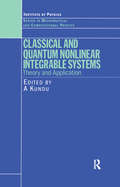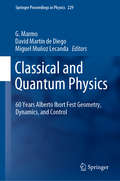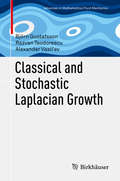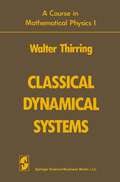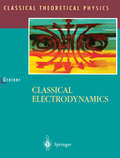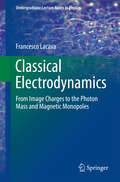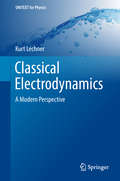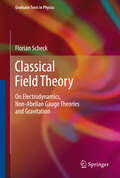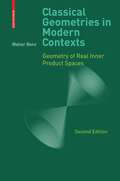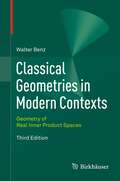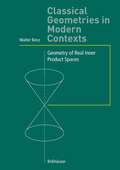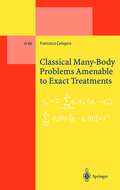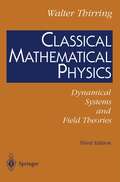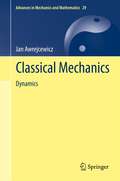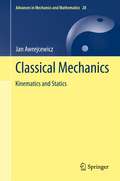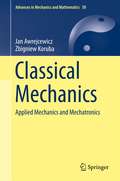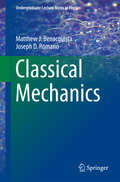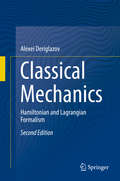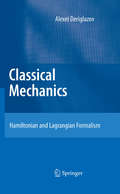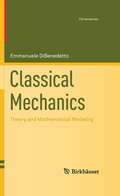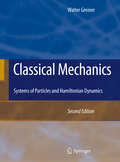- Table View
- List View
Classical and Quantum Nonlinear Integrable Systems: Theory and Application
by A KunduCovering both classical and quantum models, nonlinear integrable systems are of considerable theoretical and practical interest, with applications over a wide range of topics, including water waves, pin models, nonlinear optics, correlated electron systems, plasma physics, and reaction-diffusion processes. Comprising one part on classical theories
Classical and Quantum Nonlinear Integrable Systems: Theory and Application
by A. KunduCovering both classical and quantum models, nonlinear integrable systems are of considerable theoretical and practical interest, with applications over a wide range of topics, including water waves, pin models, nonlinear optics, correlated electron systems, plasma physics, and reaction-diffusion processes. Comprising one part on classical theories
Classical and Quantum Physics: 60 Years Alberto Ibort Fest Geometry, Dynamics, and Control (Springer Proceedings in Physics #229)
by G. Marmo David Martín de Diego Miguel Muñoz LecandaThis proceedings is based on the interdisciplinary workshop held in Madrid, 5-9 March 2018, dedicated to Alberto Ibort on his 60th birthday. Alberto has great and significantly contributed to many fields of mathematics and physics, always with highly original and innovative ideas.Most of Albertos’s scientific activity has been motivated by geometric ideas, concepts and tools that are deeply related to the framework of classical dynamics and quantum mechanics.Let us mention some of the fields of expertise of Alberto Ibort:Geometric Mechanics; Constrained Systems; Variational Principles; Multisymplectic structures for field theories; Super manifolds; Inverse problem for Bosonic and Fermionic systems; Quantum Groups, Integrable systems, BRST Symmetries; Implicit differential equations; Yang-Mills Theories; BiHamiltonian Systems; Topology Change and Quantum Boundary Conditions; Classical and Quantum Control; Orthogonal Polynomials; Quantum Field Theory and Noncommutative Spaces; Classical and Quantum Tomography; Quantum Mechanics on phase space; Wigner-Weyl formalism; Lie-Jordan Algebras, Classical and Quantum; Quantum-to-Classical transition; Contraction of Associative Algebras; contact geometry, among many others.In each contribution, one may find not only technical novelties but also completely new way of looking at the considered problems. Even an experienced reader, reading Alberto's contributions on his field of expertise, will find new perspectives on the considered topic.His enthusiasm is happily contagious, for this reason he has had, and still has, very bright students wishing to elaborate their PhD thesis under his guidance.What is more impressive, is the broad list of rather different topics on which he has contributed.
Classical and Stochastic Laplacian Growth (Advances in Mathematical Fluid Mechanics)
by Björn Gustafsson Razvan Teodorescu Alexander Vasil’evThis monograph covers a multitude of concepts, results, and research topics originating from a classical moving-boundary problem in two dimensions (idealized Hele-Shaw flows, or classical Laplacian growth), which has strong connections to many exciting modern developments in mathematics and theoretical physics. Of particular interest are the relations between Laplacian growth and the infinite-size limit of ensembles of random matrices with complex eigenvalues; integrable hierarchies of differential equations and their spectral curves; classical and stochastic Löwner evolution and critical phenomena in two-dimensional statistical models; weak solutions of hyperbolic partial differential equations of singular-perturbation type; and resolution of singularities for compact Riemann surfaces with anti-holomorphic involution. The book also provides an abundance of exact classical solutions, many explicit examples of dynamics by conformal mapping as well as a solid foundation of potential theory. An extensive bibliography covering over twelve decades of results and an introduction rich in historical and biographical details complement the eight main chapters of this monograph. Given its systematic and consistent notation and background results, this book provides a self-contained resource. It is accessible to a wide readership, from beginner graduate students to researchers from various fields in natural sciences and mathematics.
Classical Electrodynamics (Classical Theoretical Physics)
by Walter GreinerThis reference and workbook provides not only a complete survey of classical electrodynamics, but also an enormous number of worked examples and problems to show the reader how to apply abstract principles to realistic problems. The book will prove useful to graduate students in electrodynamics needing a practical and comprehensive treatment of the subject.
Classical Electrodynamics: From Image Charges to the Photon Mass and Magnetic Monopoles (Undergraduate Lecture Notes in Physics)
by Francesco LacavaThis book proposes intriguing arguments that will enable students to achieve a deeper understanding of electromagnetism, while also presenting a number of classical methods for solving difficult problems. Two chapters are devoted to relativistic electrodynamics, covering all aspects needed for a full comprehension of the nature of electric and magnetic fields and, subsequently, electrodynamics. Each of the two final chapters examines a selected experimental issue, introducing students to the work involved in actually proving a law or theory. Classical books on electricity and magnetism are mentioned in many references, helping to familiarize students with books that they will encounter in their further studies. Various problems are presented, together with their worked-out solutions. The book is based on notes from special lectures delivered by the author to students during the second year of a BSc course in Physics, but the subject matter may also be of interest to senior physicists, as many of the themes covered are completely ignored or touched only briefly in standard textbooks.
Classical Electrodynamics: A Modern Perspective (UNITEXT for Physics)
by Kurt LechnerThis book addresses the theoretical foundations and the main physical consequences of electromagnetic interaction, generally considered to be one of the four fundamental interactions in nature, in a mathematically rigorous yet straightforward way. The major focus is on the unifying features shared by classical electrodynamics and all other fundamental relativistic classical field theories. The book presents a balanced blend of derivations of phenomenological predictions from first principles on the one hand, and concrete applications on the other. Further, it highlights the internal inconsistencies of classical electrodynamics, and addresses and resolves often-ignored critical issues, such as the dynamics of massless charged particles, the infinite energy of the electromagnetic field, and the limits of the Green’s function method. Presenting a rich, multilayered, and critical exposition on the electromagnetic paradigm underlying the whole Universe, the book offers a valuable resource for researchers and graduate students in theoretical physics alike.
Classical Electromagnetism via Relativity: An Alternative Approach to Maxwell’s Equations (pdf)
by William Geraint RosserClassical Field Theory: On Electrodynamics, Non-Abelian Gauge Theories and Gravitation (Graduate Texts in Physics)
by Florian ScheckThe book describes Maxwell's equations first in their integral, directly testable form, then moves on to their local formulation. The first two chapters cover all essential properties of Maxwell's equations, including their symmetries and their covariance in a modern notation. Chapter 3 is devoted to Maxwell theory as a classical field theory and to solutions of the wave equation. Chapter 4 deals with important applications of Maxwell theory. It includes topical subjects such as metamaterials with negative refraction index and solutions of Helmholtz' equation in paraxial approximation relevant for the description of laser beams.Chapter 5 describes non-Abelian gauge theories from a classical, geometric point of view, in analogy to Maxwell theory as a prototype, and culminates in an application to the U(2) theory relevant for electroweak interactions. The last chapter 6 gives a concise summary of semi-Riemannian geometry as the framework for the classical field theory of gravitation. The chapter concludes with a discussion of the Schwarzschild solution of Einstein's equations and the classical tests of general relativity (perihelion precession of Mercury, and light deflection by the sun).------Textbook features: detailed figures, worked examples, problems and solutions, boxed inserts, highlighted special topics, highlighted important math etc., helpful summaries, appendix, index.
Classical Geometries in Modern Contexts: Geometry of Real Inner Product Spaces
by Walter BenzThis book is based on real inner product spaces X of arbitrary (finite or infinite) dimension greater than or equal to 2. Designed as a two term graduate course, the book helps students to understand great ideas of classical geometries in a modern and general context. A real benefit is the dimension-free approach to important geometrical theories. The only prerequisites are basic linear algebra and basic 2- and 3-dimensional real geometry.
Classical Geometries in Modern Contexts: Geometry of Real Inner Product Spaces Third Edition
by Walter BenzThe focus of this book and its geometric notions is on real vector spaces X that are finite or infinite inner product spaces of arbitrary dimension greater than or equal to 2. It characterizes both euclidean and hyperbolic geometry with respect to natural properties of (general) translations and general distances of X. Also for these spaces X, it studies the sphere geometries of Möbius and Lie as well as geometries where Lorentz transformations play the key role.Proofs of newer theorems characterizing isometries and Lorentz transformations under mild hypotheses are included, such as for instance infinite dimensional versions of famous theorems of A.D. Alexandrov on Lorentz transformations. A real benefit is the dimension-free approach to important geometrical theories. New to this third edition is a chapter dealing with a simple and great idea of Leibniz that allows us to characterize, for these same spaces X, hyperplanes of euclidean, hyperbolic geometry, or spherical geometry, the geometries of Lorentz-Minkowski and de Sitter, and this through finite or infinite dimensions greater than 1. Another new and fundamental result in this edition concerns the representation of hyperbolic motions, their form and their transformations. Further we show that the geometry (P,G) of segments based on X is isomorphic to the hyperbolic geometry over X. Here P collects all x in X of norm less than one, G is defined to be the group of bijections of P transforming segments of P onto segments.The only prerequisites for reading this book are basic linear algebra and basic 2- and 3-dimensional real geometry. This implies that mathematicians who have not so far been especially interested in geometry could study and understand some of the great ideas of classical geometries in modern and general contexts.
Classical Loop-in-Loop Chains: And Their Derivatives (Jewellery Ser.)
by J.R. SmithThiS is not only a book of instruction in chainmaking but it is also a work celebrating man's continuous creativity over thousands of years. At times something that man creates has far-reach ing effects; an example that quickly comes to mind is the wheel, which has enabled many devel opments, from pottery to computers. At this point it is important to note that these same wheels could not have been made without metal tools. From early Neolithic times on gold was a favorite choice in the making of jewelry. During the Neolithic period these "shining stones," probably alluvial, were prized. Actually gold was cold worked as if it were a stone. There is a surviving example of cold-worked gold from Catahuyuk (present day Turkey) estimated to have been made in 6500 B. C. There were only four metals on the earth's surface that were found in sufficient quantity to be used: gold, copper, silver, and meteoric iron. An understanding of the malleability of gold, and of the annealing effect of fire, changed jewelry making; new forms were found. Gold was no longer a piece of stone but a material that could be flattened and made very thin. Sheet and foil are the oldest forms of worked gold. The smiths' tools were stone, wood, and horn.
Classical Many-Body Problems Amenable to Exact Treatments: (Solvable and/or Integrable and/or Linearizable...) in One-, Two- and Three-Dimensional Space (Lecture Notes in Physics Monographs #66)
by Francesco CalogeroThis book focuses treatable This class on exactly many' body problems. does not include most We are therefore reminded "of physical problems. the of the man home late at after an alcoholic who, story returning night the for his under he was a knew, evening, scanning ground key lamppost; be that he had it somewhere but under the to sure, dropped else, only Yet was there to conduct a searcW' . light lamppost enough proper we feel the interest for such models is nowadays sufficiently widespread because of their their mathematical relevance and their multi beauty, farious that need be made for no our apologies applicative potential choice. In whoever undertakes to read this book will know from any case, its title what she is in for! Yet this title a of it some may require explanations: gloss (including its extended inside front follows. version, see cover) and nonrelativistic "Classical" we mean nonquantal (although By consider the which indeed some are Ruijsenaars Schneider models, treated in this relativistic versions as known, nonre book, of, previously lativistic is focussed see our on models; below): presentation mainly of whose time evolution is determined many body point particles systems Newtonian of motion to by equations (acceleration proportional force).
Classical Marble: Geochemistry, Technology, Trade (NATO Science Series E: #153)
by N. Herz Marc WaelkensMarble in Ancient Greece and Rome: Geology, Quarries, Commerce, Artifacts Marble remains the sine qua non raw material of the an cient Greeks and Romans. Beginning in the Bronze Age sculptu re began in marble and throughout classical times the most im portant statues, reliefs, monuments and inscriptions were made of it. Yet, quarry sources changed in time as preferences for different marbles were influenced by local traditions, the pos sibilities of transport, esthetic tastes, and economics. Marble studies and the identification of the provenance of marble can thus reveal much about Greek and Roman history, trade, esthe tics and technology. Persons in many disciplines are studying various aspects of Greek and Roman marble usage. Geologists and geochemists are working on methods to determine the provenance of marble; ar chaeologists are noting changing patterns of import and use in excavation~ and discovering how improving quarrying techniques and prelimihary dressing of the extracted material influenced the final shape of artifacts; ancient historians are now under standing quarry organization and bureaucracies that controlled marble production and trade; art historians are seeing how phy sical characteristics of the stone affected the techniques and style of sculpture; architects and engineers are interested in quarry technologies and usage in building construction. These specialists drawn from many disciplines rarely have an opportu nity to compare notes and see how each can contribute to the research effort of others.
Classical Mathematical Physics: Dynamical Systems and Field Theories
by Walter ThirringThis book combines the enlarged and corrected editions of both volumes on classical physics stemming from Thirrings famous course. The treatment of classical dynamical systems uses analysis on manifolds to provide the mathematical setting for discussions of Hamiltonian systems, canonical transformations, constants of motion, and perturbation theory. Problems discussed include: nonrelativistic motion of particles and systems, relativistic motion in electromagnetic and gravitational fields, and the structure of black holes. The treatment of classical fields uses the language of differential geometry, treating both Maxwells and Einsteins equations in a compact and clear fashion. The book includes discussions of the electromagnetic field due to known charge distributions and in the presence of conductors, as well as a new section on gauge theories. It discusses the solutions of the Einstein equations for maximally symmetric spaces and spaces with maximally symmetric submanifolds, and concludes by applying these results to the life and death of stars. Numerous examples and accompanying remarks make this an ideal textbook.
Classical Mechanics: Dynamics (Advances in Mechanics and Mathematics #29)
by Jan AwrejcewiczThis is the second volume of three books devoted to Mechanics. In this book, dynamical and advanced mechanics problems are stated, illustrated, and discussed, including a few novel concepts in comparison to standard text books and monographs. Apart from being addressed to a wide spectrum of graduate students, postgraduate students, researchers, and teachers from the fields of mechanical and civil engineering, this volume is also intended to be used as a self-contained material for applied mathematicians and physical scientists and researchers.
Classical Mechanics: Kinematics and Statics (Advances in Mechanics and Mathematics #28)
by Jan AwrejcewiczThis is the first volume of three, devoted to Mechanics. This book contains classical mechanics problems including kinematics and statics. It is recommended as a supplementary textbook for undergraduate and graduate students from mechanical and civil engineering, as well as for physical scientists and engineers. It contains a basic introduction to classical mechanics, including fundamental principles, statics, and the geometry of masses, as well as thorough discussion on kinematics.
Classical Mechanics: Applied Mechanics and Mechatronics (Advances in Mechanics and Mathematics #30)
by Jan Awrejcewicz Zbigniew KorubaThis is the last book of three devoted to Mechanics, and uses the theoretical background presented in Classical Mechanics: Kinematics and Statics and Classical Mechanics: Dynamics. It focuses on exhibiting a unique approach, rooted in the classical mechanics, to study mechanical and electromagnetic processes occurring in Mechatronics. Contrary to the majority of the books devoted to Applied Mechanics, this volume places a particular emphasis on theory, modeling, analysis, and control of gyroscopic devices, including the military applications. This volume provides practicing mechanical/mechatronic engineers and designers, researchers, graduate and postgraduate students with a knowledge of mechanics focused directly on advanced applications.
Classical Mechanics (Undergraduate Lecture Notes in Physics)
by Matthew J. Benacquista Joseph D. RomanoThis textbook provides an introduction to classical mechanics at a level intermediate between the typical undergraduate and advanced graduate level. This text describes the background and tools for use in the fields of modern physics, such as quantum mechanics, astrophysics, particle physics, and relativity. Students who have had basic undergraduate classical mechanics or who have a good understanding of the mathematical methods of physics will benefit from this book.
Classical Mechanics: Hamiltonian and Lagrangian Formalism
by Alexei DeriglazovThe revised edition of this advanced textbook provides the reader with a solid grounding in the formalism of classical mechanics, underlying a number of powerful mathematical methods that are widely used in modern theoretical and mathematical physics. It reviews the fundamentals of Lagrangian and Hamiltonian mechanics, and goes on to cover related topics such as canonical transformations, integral invariants, potential motion in geometric setting, symmetries, the Noether theorem and systems with constraints. While in some cases the formalism is developed beyond the traditional level adopted in the standard textbooks on classical mechanics, only elementary mathematical methods are used in the exposition of the material.New material for the revised edition includes additional sections on the Euler-Lagrange equation, the Cartan two-form in Lagrangian theory, and Newtonian equations of motion in context of general relativity. Also new for this edition is the inclusion of problem sets and solutions to aid in the understanding of the material presented.The mathematical constructions involved are explicitly described and explained, so the book is a good starting point for the student new to this field. Where possible, intuitive motivations are replaced by explicit proofs and direct computations, preserving the level of rigor that makes the book useful for more advanced students intending to work in one of the branches of the vast field of theoretical physics. To illustrate how classical-mechanics formalism works in other branches of theoretical physics, examples related to electrodynamics, as well as to relativistic and quantum mechanics, are included.
Classical Mechanics: Hamiltonian and Lagrangian Formalism
by Alexei DeriglazovFormalism of classical mechanics underlies a number of powerful mathematical methods that are widely used in theoretical and mathematical physics. This book considers the basics facts of Lagrangian and Hamiltonian mechanics, as well as related topics, such as canonical transformations, integral invariants, potential motion in geometric setting, symmetries, the Noether theorem and systems with constraints. While in some cases the formalism is developed beyond the traditional level adopted in the standard textbooks on classical mechanics, only elementary mathematical methods are used in the exposition of the material. The mathematical constructions involved are explicitly described and explained, so the book can be a good starting point for the undergraduate student new to this field. At the same time and where possible, intuitive motivations are replaced by explicit proofs and direct computations, preserving the level of rigor that makes the book useful for the graduate students intending to work in one of the branches of the vast field of theoretical physics. To illustrate how classical-mechanics formalism works in other branches of theoretical physics, examples related to electrodynamics, as well as to relativistic and quantum mechanics, are included.
Classical Mechanics: Theory and Mathematical Modeling (Cornerstones)
by Emmanuele DiBenedetto* Offers a rigorous mathematical treatment of mechanics as a text or reference * Revisits beautiful classical material, including gyroscopes, precessions, spinning tops, effects of rotation of the Earth on gravity motions, and variational principles * Employs mathematics not only as a "unifying" language, but also to exemplify its role as a catalyst behind new concepts and discoveries
